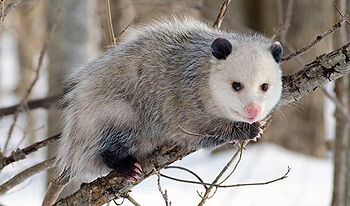


OPOSSUMS
Identification
An opossum (Didelphis virginiana) is a whitish or grayish
mammal about the size of a house cat. Underfur is dense with sparse
guard hairs. Its face is long and pointed, its ears rounded and hairless.
Maximum length is 40 inches (102 cm); the ratlike tail is slightly
less than half the total length. The tail may be unusually short in
northern opossums due to loss by frostbite. Opossums may weigh as much
as 14 pounds (6.3 kg); males average 6 to 7 pounds (2.7 to 3.2 kg)
and females average 4 pounds (6.3 kg). The skull is usually 3 to 4
inches (8 to 10 cm) long and contains 50 teeth Ñ more than are found
in any other North American mammal. Canine teeth (fangs) are prominent.
Tracks of both front and hind feet look as if they were made by little
hands with widely spread fingers. They may be distinguished
from raccoon tracks, in which hind prints appear to be made by little
feet. The hind foot of an opossum looks like a distorted hand.
Range
Opossums are found in eastern, central, and west coast states. Since
1900 they have expanded their range northward in the eastern United
States. They are absent from the Rockies, most western plains states,
and parts of the northern United States.
Habitat
Habitats are diverse, ranging from arid to moist, wooded to open
fields. Opossums prefer environments near streams or swamps. They take
shelter in burrows of other animals, tree cavities, brush piles, and
other cover. They sometimes den in attics and garages where they may
make a messy nest.
Food Habits
Foods preferred by opossums are animal matter, mainly insects or carrion.
Opossums also eat considerable amounts of vegetable matter, especially
fruits and grains. Opossums living near people may visit compost piles,
garbage cans, or food dishes intended for dogs, cats, and other pets.
General Biology, Reproduction, and Behavior
Opossums usually live alone,
having a home range of 10 to 50 acres (4 to 20 ha). Young appear to roam
randomly until they find a suitable home range. Usually they are active
only at night. The mating season is January to July in warmer parts of
the range but may start a month later and end a month earlier in northern
areas. Opossums may raise 2, rarely 3, litters per year. The opossum
is the only marsupial in North America. Like other marsupials, the blind,
helpless young develop in a pouch. They are born 13 days after mating.
The young, only 1/2 inch (1.3 cm) long, find their way into the female's
pouch where they each attach to one of 13 teats. An average of 7 young
are born. They remain in the pouch for 7 to 8 weeks. The young remain
with the mother another 6 to 7 weeks until weaned.
Most young die during their first year. Those surviving until spring will breed in that first year. The maximum age in the wild is about 7 years.
Although opossums have a top running speed of only 7 miles per hour (11.3 km/hr), they are well equipped to escape enemies. They readily enter burrows and climb trees. When threatened, an opossum may bare its teeth, growl, hiss, bite, screech, and exude a smelly, greenish fluid from its anal glands. If these defenses are not successful, an opossum may play dead.
When captured or surprised during daylight, opossums appear stupid
and inhibited. They are surprisingly intelligent, however. They rank
above dogs in some learning and discrimination tests.
Damage
Although opossums may be considered desirable as game animals,
certain individuals may be a nuisance near homes where they may get into
garbage, bird feeders, or pet food. They may also destroy poultry, game
birds, and their nests.
Legal Status
Laws protecting opossums vary from state to state. Usually
there are open seasons for hunting or trapping opossums. It is advisable
to contact local wildlife authorities before removing nuisance animals.
Bats Birds Chipmunks Feral Cats Mice Opossums Raccoons Skunks Snakes Squirrels Woodchucks

